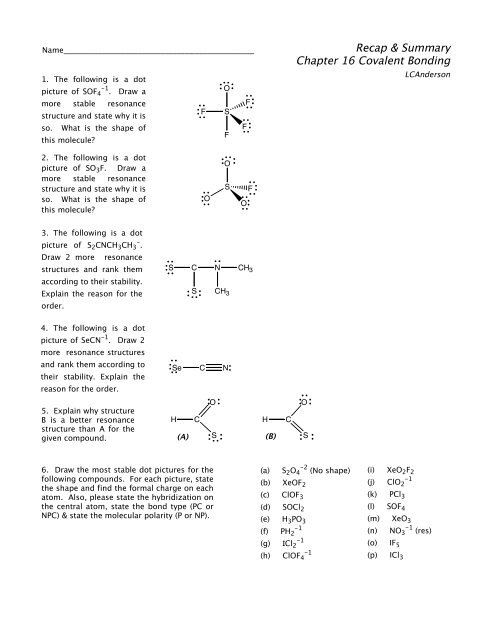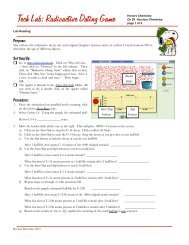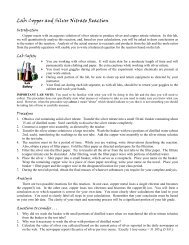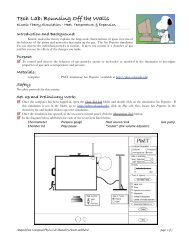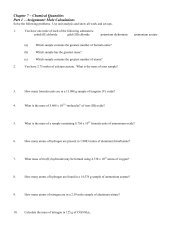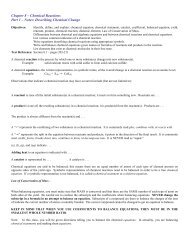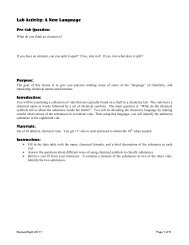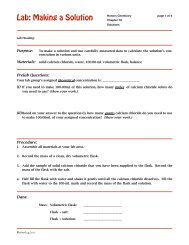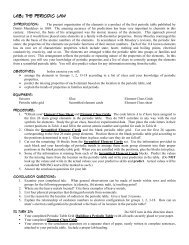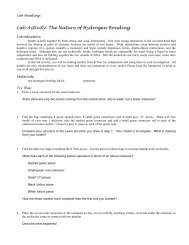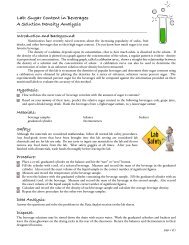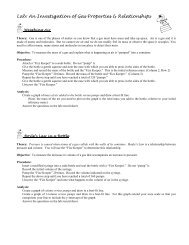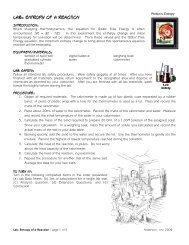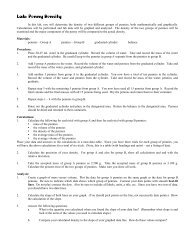Chapter 16 Recap - Honors Chemistry Coursework
Chapter 16 Recap - Honors Chemistry Coursework
Chapter 16 Recap - Honors Chemistry Coursework
Create successful ePaper yourself
Turn your PDF publications into a flip-book with our unique Google optimized e-Paper software.
Name_________________________________________________1. The following is a dot-1picture of SOF 4 . Draw aOmore stable resonanceFF Sstructure and state why it isso. What is the shape ofFFthis molecule?<strong>Recap</strong> & Summary<strong>Chapter</strong> <strong>16</strong> Covalent BondingLCAnderson2. The following is a dotpicture of SO 3 F. Draw amore stable resonancestructure and state why it isso. What is the shape ofthis molecule?OOSOF3. The following is a dotpicture of S 2 CNCH 3 CH 3- .Draw 2 more resonancestructures and rank themaccording to their stability.Explain the reason for theorder.SCSNCH 3CH 34. The following is a dotpicture of SeCN -1 . Draw 2more resonance structuresand rank them according totheir stability. Explain thereason for the order.Se C N5. Explain why structureB is a better resonancestructure than A for thegiven compound.H(A)COSH(B)COS6. Draw the most stable dot pictures for thefollowing compounds. For each picture, statethe shape and find the formal charge on eachatom. Also, please state the hybridization onthe central atom, state the bond type (PC orNPC) & state the molecular polarity (P or NP).(a)S 2 O 4-2 (No shape)(b) XeOF 2(c) ClOF 3(d) SOCl 2(e) H 3 PO 3(f)-1PH 2(g) ICl 2-1(h) ClOF 4-1(i) XeO 2 F 2(j)-1ClO 2(k) PCl 3(l) SOF 4(m) XeO 3(n)-1NO 3 (res)(o) IF 5(p) ICl 3
Answer the following questions as directed.7. Classify each statement as AT (always true), ST (sometimes true), or NT (never true).__________ a. In a polar covalent bond, the more electronegative atom has a partial positive charge.__________ b. In general, the electronegativity values of nonmetallic elements are greater than theelectronegativity values of metallic elements.__________ c. A molecule with polar bonds is dipolar.__________ d. If the electronegativity difference between two atoms is greater than 2.0, they willform an ionic bond.__________ e. Dispersion forces are weaker than hydrogen bonds.8. Arrange the following in order of increasing strength: covalent bonds, dipole-dipole interactions,dispersion forces, hydrogen bonds, ionic bonds, and metallic bonds.9. Classify each statement as TRUE or FALSE by writing the word in the blank. If the statement is false,make a positive correction to change the statement to a true statement.__________ a. Some positive regions of a polar molecule are slightly negative and some are slightlypositive.__________ b. A molecule containing polar bonds is always polar.__________ c. A molecule that has two poles is called a dipolar molecule.__________ d. When polar molecules are placed in an electric field, they all line up with the sameorientation in relation to the charged plates.__________ e. Dispersion generally decrease in strength as the number of electrons in a moleculeincreases.10. Complete the following table comparing ionic and covalent compounds. (If you need assistance, seepage 465 in your text.)Characteristic Ionic Compound Covalent CompoundRepresentative UnitGeneral Physical StateRelative Melting PointSolubility in Water11. Explain the differences in the boiling points of the following compounds:HCl (-85 o C), HF (20 o C), TiCl 4 (136 o C), and CsCl (1290 o )12. Differentiate between an intermolecular attraction and an intramolecular attraction. Are thefollowing inter- or intramolecular attractions:(a) covalent bonds (b) dipole-dipole forces (c) dispersion forces(d) hydrogen bonds (e) ionic bonds (f) metallic bonds


